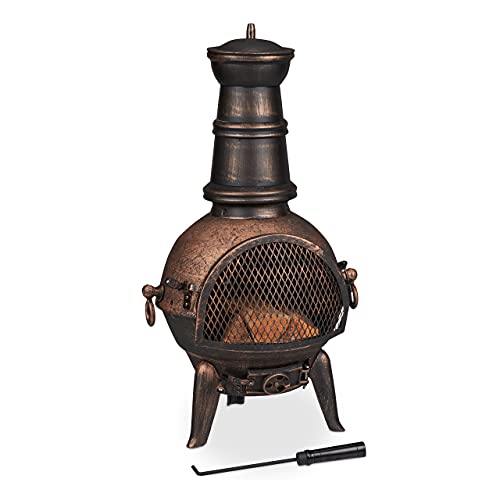What Can A Weekly Propane Chiminea Project Can Change Your Life
페이지 정보

본문
 A Propane Chiminea Will Keep Your Patio Cozy For Hours
A Propane Chiminea Will Keep Your Patio Cozy For HoursKeep your patio cosy through alfresco lunches, sunset cocktail hours, and evenings under the stars with this propane chiminea. Choose the model that is most suitable to your needs and space while focusing on safety and maintenance requirements.
 A freestanding front-loading fireplace that has an elongated body and a vertical chimney, chimineas (pronounced Chee-mi-NEH-yah) are a wonderful option for any outdoor living space. They create a cozy, easy-to-control atmosphere like other wood-burning heaters.
A freestanding front-loading fireplace that has an elongated body and a vertical chimney, chimineas (pronounced Chee-mi-NEH-yah) are a wonderful option for any outdoor living space. They create a cozy, easy-to-control atmosphere like other wood-burning heaters.Safety
A Chiminea is a fireplace for outdoor use that is designed to keep an open flame burning for a long duration. It is made of clay or steel and looks like an urn with an elongated chimney that focuses smoke. It is a fantastic choice for a garden where you need to heat it as well as cook. Some models feature a grill on the top that can be used to cook meals over the fire. Chimineas should be set on a fire-safe surface like brick, concrete, or stone patios. It is recommended to keep it at least 30 feet from any combustible structures, including houses. structures.
Chimineas provide a higher level of safety than fire chiminea pits, as the smoke and flames are contained within the structure. This makes them less prone to cause accidents and injuries. It's also easier to control the size of the fire in a chiminea since air is able to enter the front of the bowl and is directed up into the stack. This natural draft keeps the fire burning with not any effort on your part.
Chiminesas can be used to create ambiance in your outdoor living space because it generates radiant heat that emits an authentic campfire vibe. In addition, it provides a warm environment for family and friends to enjoy the night air. You can also add logs to the flames to create an ambiance of crackle and pop.
However, a chiminea is more difficult to set up and maintain than a fire pit. Sand must be placed on the bottom of a chiminea, unlike a firepit before lighting the fire. This is to protect the clay from cracking when it heats up. You should also place it on a fire-proof surface and keep it at a distance of 10 to 20 feet from walls, trees or fences as well as other combustible structures.
Both fire pits and chimineas can be used to provide warmth to your home, but you need to choose the best one for your needs. Take into consideration the aesthetics, maintenance requirements and fuel efficiency of each model to make an informed decision. Also evaluate your lifestyle and decide if you'll be using the heater to entertain frequently or for quiet family evenings at home.
Fuel
The propane chiminea is used to cook and heat. The majority of chimineas are made from clay, however cast iron and steel are also available. Certain models blend both kinds of materials and give you the classic look of a chiminea and the gas-powered heat.
The fuel you choose for your chiminea will influence the duration of time it burns, its temperature and other elements. You'll also need to weigh the short and long-run costs for fuel against installation and maintenance requirements.
Propane is a superior alternative to ethanol or wood. It's smellless, and provides plenty of warmth with minimal effort. It is a widely used ingredient used in heaters and cookware which means you shouldn't have any trouble finding it. And you won't have to spend much time tending the flame of a propane stove, as it usually starts with the flip of a switch.
There are some drawbacks when using a chiminea that is powered by propane. First of all, it isn't as green an choice as wood or ethanol. It's a fossil-fuel, the result of natural refinery and gas processing. As a result, it's not particularly good for the environment. Furthermore, it's also more expensive than ethanol or wood.
It is also important to consider the smoke generated by your chiminea, as well as any local regulations that could apply to outdoor burning. Kiln-dried heat logs or firewood are great options for chimineas since they release small amounts of smoke. They are also safe for use in Smoke Control Areas.
Your final choice will come down to your personal preferences and lifestyle requirements. Both options offer a dramatic focal point for your outdoor space, but you may need to prioritize safety features and maintenance requirements when making a decision. Additionally, you'll have to determine how often you plan on using your outdoor fire pit or chiminea so that you can choose the most suitable fuel type to meet your requirements. You can make the right choice and feel the warmth of your new chiminea in years to come.
Ventilation
If you're a fan outdoor fires, a chiminea could be the ideal choice. They are a great source of heat and style and they also feature an airy draft that keeps the fire burning with no tending. You'll be less stressed about the flames and spend more time with your friends and family.
Chimineas have a bowl with an assortment of sticks which creates a natural draft. The air is drawn into the front of the bowl and flows upwards through the stack, and exits out the top. This design helps reduce the amount of smoke and ash that is produced, making it safer for you to be nearer to the fire. Although a chiminea is able to be used indoors, it is recommended to keep it a good distance away from anything flammable because sparks will always be flying around.
There are many ways to cut down on the amount of smoke created by your chiminea. Use Duraflame logs in ceramic chimineas, which don't emit a lot of smoke. You can also set your chiminea in a place that is not exposed to wind. These two suggestions will allow you to enjoy your chiminea with no concerns about causing trouble to your neighbors or damaging patio furniture.
Both chimineas made of clay and models made of cast iron or steel are long-lasting however, you need to be sure to shield them from the elements. The best way to achieve this is to apply a sealer or acrylic coating to the outside of your chiminea prior begin using it. This will help protect it from fading and cracking because of exposure to sunlight. It is a good idea to apply this coating every six to eight weeks of usage.
If you are ready to light a fire, you can place your chiminea onto the stand that came with it. Don't place it on an area that could be flammable like a deck. Also, clean out any debris or combustible materials around it prior to lighting a fire.
If you're a frequent fire-starter it is essential to prepare your chiminea for the season before you begin using it frequently. You should only use just a few pieces of seasoned, dried wood and kindling to create your first few small fires. These initial small controlled burns can aid in sealing the clay and lessen hair-line cracks that could be problematic.
Maintenance
It is essential to keep your chiminea in good condition as you would any other furniture you use outdoors. If you regularly clean it and protect it from the elements by using a waterproof cover, it will last longer.
Chimineas can crack when they're not properly taken care of. In addition to the obvious avoid dropping it or pound it with a hammer - improper burning techniques and not paying attention to maintenance can result in cracking of the clay chiminea.
A good chiminea manual is essential. This should be provided with your chiminea. It should explain how often you need to clean it and any other special methods to maintain the clay. The majority of people use the bicarbonate soda paste method of cleaning described above. They do this 2-3 times per year, or more often in the summer when they are using it the most. After cleaning your chiminea it's worth giving it a quick rinse with clean water. Then, you can return the sand or gravel to the bottom of the base.
If you're concerned about cracks, it could be worth considering a cast-iron chiminea terracotta. It's more durable than clay chimineas. Even cast iron chimineas are prone to rust which is why it's essential to keep them dry and away from burning combustibles.
It's also a good idea, in addition to cleaning your chiminea to invest in a protective cover and a grate that is weatherproof, such as this one from Amazon which will safeguard it while you are not using it. A grate can be beneficial if your Chiminea is located in an open-plan living space with soft furnishings near it. It will stop hot ash from flying all over the place.
A chiminea uk reduces the amount of smoke that is produced in your outdoor space. It has a sealed chimney which directs smoke upwards and away from those who are smoking or having a bonfire. However, it's a good idea to only use wood that is seasoned to lessen the amount of sparks as this could cause an abundance of smoke.
- 이전글ChatGPT Leest Antwoorden nu Hardop Voor, ook in het Nederlands 24.12.31
- 다음글비아그라후유증 레비트라 부작용 24.12.31
댓글목록
등록된 댓글이 없습니다.


